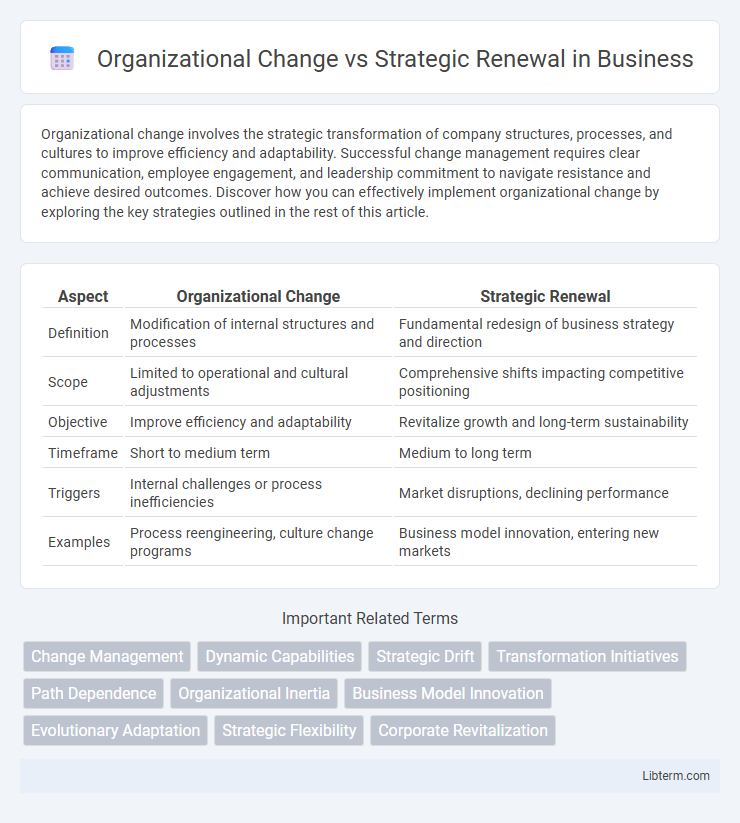Organizational change involves the strategic transformation of company structures, processes, and cultures to improve efficiency and adaptability. Successful change management requires clear communication, employee engagement, and leadership commitment to navigate resistance and achieve desired outcomes. Discover how you can effectively implement organizational change by exploring the key strategies outlined in the rest of this article.
Table of Comparison
| Aspect | Organizational Change | Strategic Renewal |
|---|---|---|
| Definition | Modification of internal structures and processes | Fundamental redesign of business strategy and direction |
| Scope | Limited to operational and cultural adjustments | Comprehensive shifts impacting competitive positioning |
| Objective | Improve efficiency and adaptability | Revitalize growth and long-term sustainability |
| Timeframe | Short to medium term | Medium to long term |
| Triggers | Internal challenges or process inefficiencies | Market disruptions, declining performance |
| Examples | Process reengineering, culture change programs | Business model innovation, entering new markets |
Introduction to Organizational Change and Strategic Renewal
Organizational change involves the process through which companies adapt their structures, strategies, or cultures to respond to internal and external pressures, aiming for improved efficiency and competitiveness. Strategic renewal refers to the continuous revitalization of an organization's core capabilities, business models, and market positioning to sustain long-term growth and innovation. Understanding the distinctions and interplay between organizational change and strategic renewal is essential for businesses seeking to navigate evolving environments and maintain competitive advantage.
Defining Organizational Change
Organizational change involves modifications in a company's structure, processes, or culture aimed at improving efficiency and adapting to external pressures. It typically addresses short-term adjustments and incremental improvements within existing frameworks. Unlike strategic renewal, which redefines an organization's core business and long-term direction, organizational change focuses on operational shifts to enhance performance.
Understanding Strategic Renewal
Strategic renewal involves fundamentally reorienting an organization's core strategies, resources, and capabilities to adapt to changing market conditions and sustain long-term competitive advantage. Unlike routine organizational change, which typically addresses incremental improvements or operational adjustments, strategic renewal requires deep innovation in business models, leadership vision, and organizational culture. Emphasizing continuous learning and flexibility, strategic renewal enables firms to proactively reshape their strategic direction in response to external disruptions and emerging opportunities.
Key Differences Between Organizational Change and Strategic Renewal
Organizational change typically involves adjustments to processes, structures, or behaviors within an existing framework to improve efficiency or address immediate issues. In contrast, strategic renewal entails a fundamental transformation of an organization's direction, often redefining its core mission, capabilities, and market positioning to ensure long-term competitiveness. While organizational change focuses on short-term adaptability, strategic renewal targets sustained growth and innovation at a systemic level.
Drivers of Organizational Change
Drivers of organizational change include technological advancements, market competition, regulatory shifts, and evolving consumer preferences, which compel companies to adapt their structures and processes. Strategic renewal focuses on leveraging these drivers to redefine core capabilities, innovate business models, and reposition the organization for long-term growth. Recognizing external and internal factors such as leadership vision, resource allocation, and environmental turbulence is essential for effectively managing both organizational change and strategic renewal initiatives.
Drivers of Strategic Renewal
Strategic renewal is driven by market disruptions, technological advancements, and evolving customer preferences that demand a fundamental rethinking of a company's business model and competitive positioning. Unlike organizational change, which often targets incremental improvements within existing frameworks, strategic renewal requires visionary leadership to identify new growth opportunities and realign resources accordingly. The ability to sense and seize strategic opportunities enables firms to sustain long-term competitive advantage amid dynamic industry landscapes.
Impact on Organizational Culture and Structure
Organizational change often results in incremental adjustments that influence specific aspects of culture and structure, leading to shifts in employee behaviors and workflow processes. Strategic renewal encompasses comprehensive transformations that redefine organizational identity, deeply reshaping core values, cultural norms, and structural frameworks to enhance long-term adaptability and competitive advantage. The impact on organizational culture during strategic renewal is profound, fostering a culture of innovation and resilience, whereas organizational change typically aims at improving efficiency within existing cultural paradigms.
Challenges in Implementing Change vs Renewal
Organizational change often faces challenges such as employee resistance, lack of clear communication, and disruption of existing workflows, making implementation difficult and slow. Strategic renewal requires overcoming deeper obstacles, including re-aligning core competencies, shifting corporate culture, and reallocating resources, which can threaten established power structures and long-term stability. Both processes demand strong leadership commitment and effective change management to successfully navigate complexities and drive sustainable growth.
Measuring Success: Change vs Renewal Outcomes
Measuring success in organizational change centers on short-term performance improvements, employee adaptation, and process efficiency, while strategic renewal outcomes emphasize long-term competitive advantage, innovation capacity, and market repositioning. Key metrics for change include adoption rates, reduced resistance, and operational KPIs, whereas renewal success relies on sustained revenue growth, increased strategic flexibility, and enhanced organizational learning. Effective evaluation combines quantitative data with qualitative insights to capture both immediate change effectiveness and the ongoing impact of strategic renewal initiatives.
Best Practices for Integrating Change and Renewal Strategies
Integrating organizational change and strategic renewal requires aligning transformation initiatives with long-term innovation goals to sustain competitive advantage. Best practices emphasize continuous communication, stakeholder engagement, and leveraging data-driven insights to adapt and refine strategies dynamically. Embedding flexibility in processes and fostering a culture of learning accelerates the successful adoption of both incremental changes and breakthrough renewals.
Organizational Change Infographic

 libterm.com
libterm.com